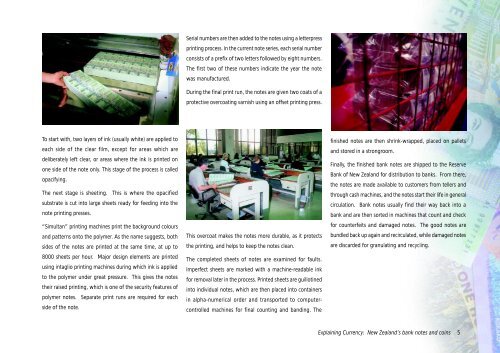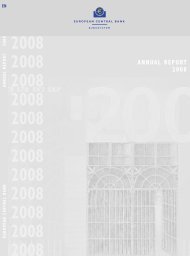Explaining Currency: New Zealand's bank notes and coins
Explaining Currency: New Zealand's bank notes and coins
Explaining Currency: New Zealand's bank notes and coins
You also want an ePaper? Increase the reach of your titles
YUMPU automatically turns print PDFs into web optimized ePapers that Google loves.
Serial numbers are then added to the <strong>notes</strong> using a letterpressprinting process. In the current note series, each serial numberconsists of a prefix of two letters followed by eight numbers.The first two of these numbers indicate the year the notewas manufactured.During the final print run, the <strong>notes</strong> are given two coats of aprotective overcoating varnish using an offset printing press.To start with, two layers of ink (usually white) are applied toeach side of the clear film, except for areas which aredeliberately left clear, or areas where the ink is printed onone side of the note only. This stage of the process is calledopacifying.The next stage is sheeting. This is where the opacifiedsubstrate is cut into large sheets ready for feeding into thenote printing presses.“Simultan” printing machines print the background colours<strong>and</strong> patterns onto the polymer. As the name suggests, bothsides of the <strong>notes</strong> are printed at the same time, at up to8000 sheets per hour. Major design elements are printedusing intaglio printing machines during which ink is appliedto the polymer under great pressure. This gives the <strong>notes</strong>their raised printing, which is one of the security features ofpolymer <strong>notes</strong>. Separate print runs are required for eachside of the note.This overcoat makes the <strong>notes</strong> more durable, as it protectsthe printing, <strong>and</strong> helps to keep the <strong>notes</strong> clean.The completed sheets of <strong>notes</strong> are examined for faults.Imperfect sheets are marked with a machine-readable inkfor removal later in the process. Printed sheets are guillotinedinto individual <strong>notes</strong>, which are then placed into containersin alpha-numerical order <strong>and</strong> transported to computercontrolledmachines for final counting <strong>and</strong> b<strong>and</strong>ing. Thefinished <strong>notes</strong> are then shrink-wrapped, placed on pallets<strong>and</strong> stored in a strongroom.Finally, the finished <strong>bank</strong> <strong>notes</strong> are shipped to the ReserveBank of <strong>New</strong> Zeal<strong>and</strong> for distribution to <strong>bank</strong>s. From there,the <strong>notes</strong> are made available to customers from tellers <strong>and</strong>through cash machines, <strong>and</strong> the <strong>notes</strong> start their life in generalcirculation. Bank <strong>notes</strong> usually find their way back into a<strong>bank</strong> <strong>and</strong> are then sorted in machines that count <strong>and</strong> checkfor counterfeits <strong>and</strong> damaged <strong>notes</strong>. The good <strong>notes</strong> arebundled back up again <strong>and</strong> recirculated, while damaged <strong>notes</strong>are discarded for granulating <strong>and</strong> recycling.<strong>Explaining</strong> <strong>Currency</strong>: <strong>New</strong> Zeal<strong>and</strong>’s <strong>bank</strong> <strong>notes</strong> <strong>and</strong> <strong>coins</strong> 5





![KNOW YOUR NEW GIBRALTAR BANKNOTES - [Home] bThe/b](https://img.yumpu.com/50890985/1/184x260/know-your-new-gibraltar-banknotes-home-bthe-b.jpg?quality=85)
![PAPUA NEW GUINEA - [Home] - Polymer Bank Notes of the World](https://img.yumpu.com/49758743/1/190x143/papua-new-guinea-home-polymer-bank-notes-of-the-world.jpg?quality=85)









